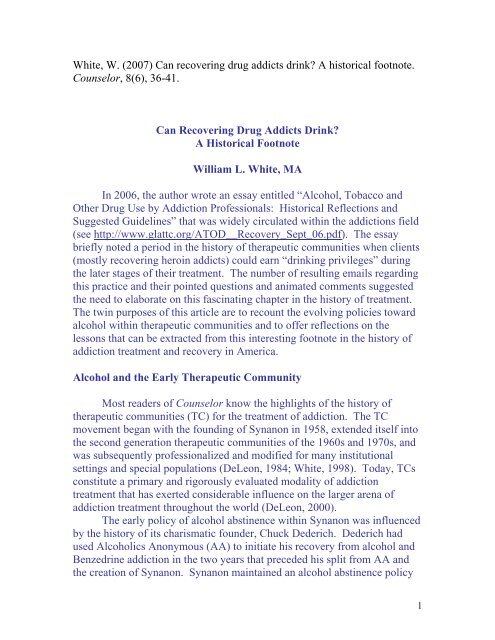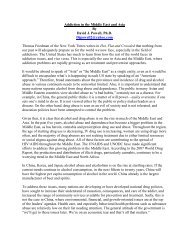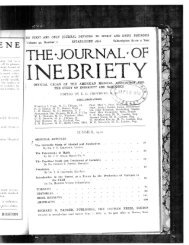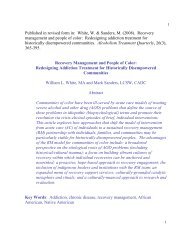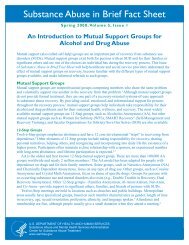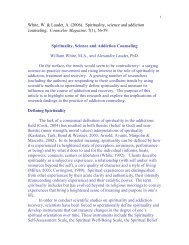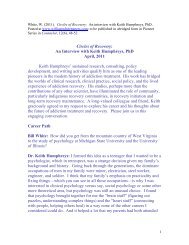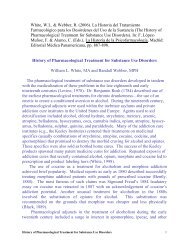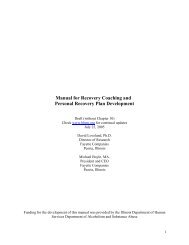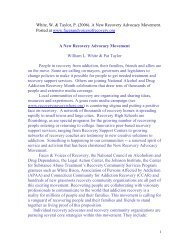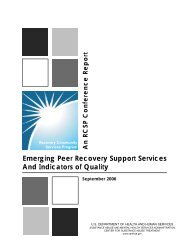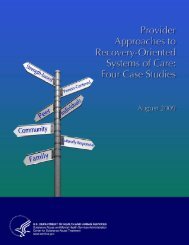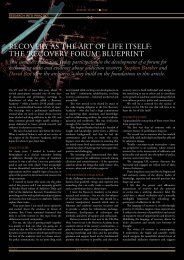Can Drug Addicts Drink - William L. White
Can Drug Addicts Drink - William L. White
Can Drug Addicts Drink - William L. White
Create successful ePaper yourself
Turn your PDF publications into a flip-book with our unique Google optimized e-Paper software.
<strong>White</strong>, W. (2007) <strong>Can</strong> recovering drug addicts drink? A historical footnote.Counselor, 8(6), 36-41.<strong>Can</strong> Recovering <strong>Drug</strong> <strong>Addicts</strong> <strong>Drink</strong>?A Historical Footnote<strong>William</strong> L. <strong>White</strong>, MAIn 2006, the author wrote an essay entitled “Alcohol, Tobacco andOther <strong>Drug</strong> Use by Addiction Professionals: Historical Reflections andSuggested Guidelines” that was widely circulated within the addictions field(see http://www.glattc.org/ATOD__Recovery_Sept_06.pdf). The essaybriefly noted a period in the history of therapeutic communities when clients(mostly recovering heroin addicts) could earn “drinking privileges” duringthe later stages of their treatment. The number of resulting emails regardingthis practice and their pointed questions and animated comments suggestedthe need to elaborate on this fascinating chapter in the history of treatment.The twin purposes of this article are to recount the evolving policies towardalcohol within therapeutic communities and to offer reflections on thelessons that can be extracted from this interesting footnote in the history ofaddiction treatment and recovery in America.Alcohol and the Early Therapeutic CommunityMost readers of Counselor know the highlights of the history oftherapeutic communities (TC) for the treatment of addiction. The TCmovement began with the founding of Synanon in 1958, extended itself intothe second generation therapeutic communities of the 1960s and 1970s, andwas subsequently professionalized and modified for many institutionalsettings and special populations (DeLeon, 1984; <strong>White</strong>, 1998). Today, TCsconstitute a primary and rigorously evaluated modality of addictiontreatment that has exerted considerable influence on the larger arena ofaddiction treatment throughout the world (DeLeon, 2000).The early policy of alcohol abstinence within Synanon was influencedby the history of its charismatic founder, Chuck Dederich. Dederich hadused Alcoholics Anonymous (AA) to initiate his recovery from alcohol andBenzedrine addiction in the two years that preceded his split from AA andthe creation of Synanon. Synanon maintained an alcohol abstinence policy1
until 1978, at which time alcohol was experimentally introduced first forboard members and senior staff and then to others within the Synanoncommunity. Alcohol problems grew within Synanon in the 1980s andcontributed to Charles Dederich’s fall from grace and Synanon’s eventualimplosion as an organization (Mitchell, Mitchell, & Ofshe, 1980; Janzen,2001).The second generation TCs of the 1960s and early 1970s (e.g., TuumEst, Amity, Daytop Village, Gateway, Phoenix House, Gaudenzia, ArchwayHouse, to name just a few) varied in their alcohol policies depending onwhen they were founded. Most emulated Synanon’s early alcoholabstinence policy during their first years of operation, but as with Synanon,this changed over time. Part of the reason for this shift was the absence atthat time of a well-articulated rationale for why a former heroin addictshould abstain from alcohol.During the 1960s and much of the 1970s, there was an “alcoholismfield” and a “drug abuse” field—each operating in virtual isolation from oneanother. There were local drug programs and local alcoholism programs,with only a few brave programs experimenting with what was first called“combined treatment” (of alcoholics and addicts). TCs and Twelve Stepprograms constituted separate worlds, with TCs believing that they weredifferent from and superior to anything that had come before. Within thelarger fields, there were separate national institutes (that still remain),separate state agencies, separate professional associations, separatecounselor training programs, separate counselor credentialing bodies, andseparate local community advocacy groups—all split along the alcohol anddrugs demarcation. Most importantly, there was no universally acceptedconcept of “addiction” or “chemical dependency” that provided a bridge inlinking alcoholism to addiction to opiates and other traditionally defined“drugs”. It is only in the context of such separation that the continuinghistory is understandable.From Abstinence to <strong>Drink</strong>ing PrivilegesThe first change in alcohol policies within American TCs occurred inDaytop in New York City. In 1965, a party was held to celebrate memberswho had been drug free in Daytop for 1-2 years. <strong>Drink</strong>ing was permitted atthis celebration, and the event was completed without any incidents ofintoxication. In late 1966 and early 1967, the option of social drinking incertain circumstances was formally discussed in management meetings atDaytop. It was decided that social drinking (defined as drinking 1-2 drinks2
of alcohol in a social situation in the presence of more senior members of thecommunity) would be permitted as an earned privilege for thoseapproaching community reentry and by others (staff and graduates) in goodstanding within Daytop. At the “confirmation” signaling the end of phaseone treatment, the client was taken out to dinner by senior TC staff. Theclient was expected to drink wine at dinner as a token of congratulations onhis or her progress in treatment. The goal was also to provide a model formoderate drinking as part of one’s community reentry experience.Several things are noteworthy related to this practice. First, this wasintroduced into a community of recovering heroin addicts, many of whomhad no prior history of drinking except to medicate the sickness of heroinwithdrawal. Second, those with alcohol problems that preceded or coexistedwith heroin addiction were given a clear message to avoid drinking.It was assumed by TC leaders at this time that the percentage of TCmembers vulnerable for alcoholism was about what it would be in thegeneral population—estimated at that time to be about 6-10%. Third, thispolicy change did not constitute permission for intoxication. Intoxicationwas confronted and, if repeated, resulted in a loss of status in the TC.Fourth, problems related to this change in policy were not immediatelyevident (the supportive cocoon of the TC “family” may have prevented orslowed development of such problems). As a result, this relaxed policy onalcohol was transmitted to a large number of other second generation TCsthrough the influence of Daytop and then from second to third generationTCs. This evolution in TC alcohol policies unfolded within the larger drugtreatment field (non-TC programs) that excluded alcohol from its stated goalof post-treatment abstinence.The first signs of problems with the alcohol policy within Daytop andother TCs followed a predictable two-stage pattern. The first stage was theappearance of drinking at social events within the TC community (e.g., staffparties) and at outside professional conferences that exceeded the bounds ofsocial drinking and sparked other inappropriate behaviors. The second wasthe development of severe alcohol problems (or relapse back to heroin andother drugs while under the influence of alcohol) among some TC staff andgraduates. The development of alcohol problems among those who left theTC for the community was not evident early on but became more visibleover time and as follow-up became more routine and rigorous.The alcohol-related problems of TC staff were significant enough thatsome TCs developed formal relationships with alcoholism treatmentprograms to which they could refer staff for treatment. In spite of theseearly alcohol-related casualties, the relaxed policies toward alcohol and the3
practice of “drinking privileges” continued in many TCs well into the early1980s. A factor that slowed the recognition of the problem of alcohol wasthe presence of “ex-addicts” who were drinking socially and without anyevident alcohol problems. These normal drinkers masked the reality ofindividuals who had significant leadership positions within various TCs wholiterally were drinking, and eventually drank, themselves to death. Afteralcohol policies changed, some staff who had resumed drinking under theearlier policies continued to drink in the following years. This created anuncontrolled experiment of social drinking among former heroin addictswhose outcome has never been formally investigated.Changing Alcohol PoliciesAs alcohol problems were emerging in many TCs, one individual,Michael Darcy, and one TC, Gateway Foundation, took the lead in callingupon the larger TC movement to rethink its policies on alcohol. Gateway isa second-generation TC (founded in 1968) that was heavily influenced byDaytop. Gateway emulated Daytop’s drinking policy, but began toreevaluate that policy after eight of its first ten staff members developedalcohol problems after successfully recovering from addiction to heroin andother drugs. Gateway changed its alcohol policies through several stepsover the course of 1973-1974. It began by introducing an alcohol abstinencephilosophy and negotiating a formal arrangement with the Grant HospitalAlcoholism Treatment Unit to treat any Gateway staff experiencing alcoholrelatedproblems. It then contracted with the Lutheran General AlcoholismProgram to provide system-wide training within Gateway on alcoholism andits treatment, and began integrating Twelve Step philosophy into its existingTC philosophy.There was considerable resistance early on within Gateway and thelarger TC movement to the alcohol policy change. Early adoption of thispolicy change in other TCs began in the late 1970s and early 1980s and thenspread slowly to most TCs by the mid-1990s. Several things helpedconsolidate this shift in TC philosophy. There was the pioneering work ofearly TCs that integrated the treatment of opiate addicts and alcoholics(Eagleville Hospital and the influence of Dr. Don Ottenberg is particularlynoteworthy here). There was the eventual merger of the alcoholism anddrug abuse fields and local alcoholism and addiction treatment programs.There was growing scientific evidence on the phenomenon of crossaddiction,including early studies noting alcohol problems among TCgraduates in the US and Europe (Ogborne & Mellote, 1977).4
norm among persons entering addiction treatment. This trend is renderingclinically anachronistic such concepts as “drug choice”.In spite of the quite different drug cultures that surround the use ofparticular drugs, at a neurological level, these substances share morecommonalities than differences (Nature Neuroscience, 2005). While thatpotentially explains the propensity for cross-addiction, it leaves unansweredthe question of how some individuals are able to recover from livesdevastated by heroin addiction and then maintain non-problematic drinkingwhile others achieve recovery from heroin addiction only to have their livesdevastated by alcohol. This complex finding is one of the legacies of the TCmovement’s experiment with drinking privileges. Perhaps many or most (aquestion the scientists need to answer for us) people entering addictiontreatment possess a lifelong vulnerability for addiction to a broad spectrumof substances (and experiences), while in others that vulnerability is transientor restricted to a particular drug or class of drugs.Until such questions can be answered scientifically, we have a clinicalresponsibility to share warnings related to the field’s experience with thisissue. At the same time, we have the responsibility to honestly acknowledgethat there is much we do not know about these varied patterns ofvulnerability and resilience. Lacking science, we need to offer explanatorymodels that help each client make personalized, informed choices related tothe whole spectrum of psychoactive drug use.Acknowledgement: I would like to thank the many TC pioneers whoagreed to be interviewed for this article. Particular thanks for theirwillingness to discuss the evolution in policies toward alcohol use inAmerican therapeutic communities go to Michael Darcy, President/CEO ofGateway Foundation, Inc.; David Deitch, Chief Clinical Director, PhoenixHouse Foundation; Charles Devlin (now retired), former Sr. Vice Presidentof Treatment Services, Daytop; Michael Harle, President and ExecutiveDirector of Gaudenzia, Inc.; and John Ruocco (now retired), Founder ofGaudenzia and former Director of Reentry Programming, Phoenix House.About the Author: <strong>William</strong> <strong>White</strong> is a Senior Research Consultant atChestnut Health Systems and author of Slaying the Dragon: The History ofAddiction Treatment and Recovery in America.References6


